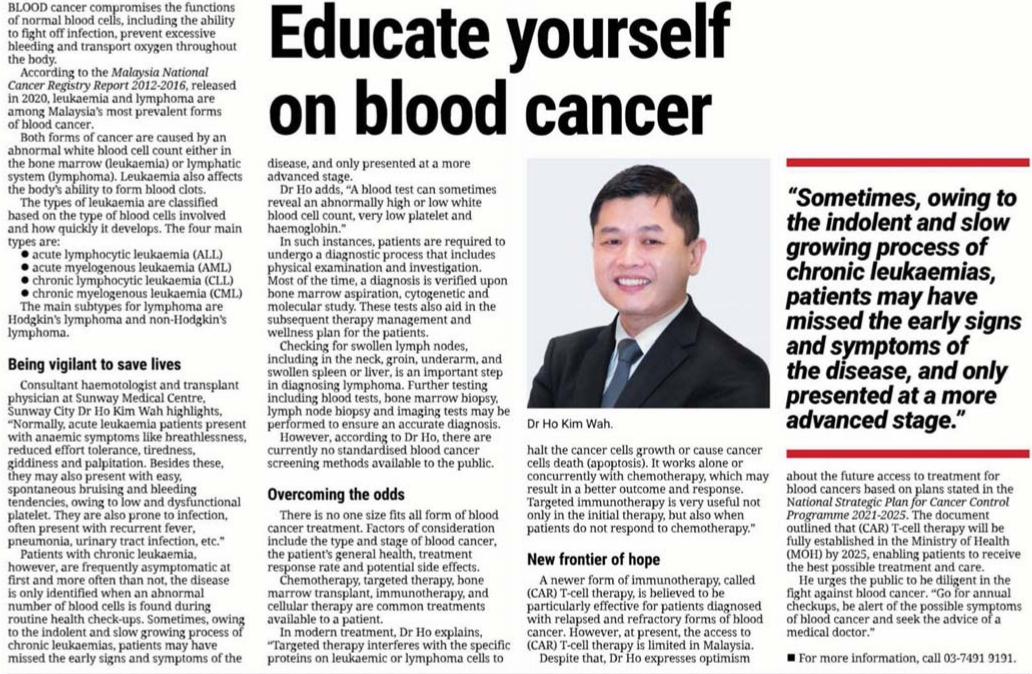Understanding Blood Cancer
04 February 2023
 Blood cancer compromises the functions of normal blood cells, including the ability to fight off infection, prevent excessive bleeding and transport oxygen throughout the body.
Blood cancer compromises the functions of normal blood cells, including the ability to fight off infection, prevent excessive bleeding and transport oxygen throughout the body.
According to the Malaysia National Cancer Registry Report 2012-2016, released in 2020, leukaemia and lymphoma are among Malaysia’s most prevalent forms of blood cancer.
Both forms of cancer are caused by an abnormal white blood cell count either in the bone marrow (leukaemia) or lymphatic system (lymphoma). Leukaemia also affects the body’s ability to form blood clots.
The types of leukaemia are classified based on the type of blood cells involved and how quickly it develops. The four main types are:
- acute lymphocytic leukaemia (ALL)
- acute myelogenous leukaemia (AML)
- chronic lymphocytic leukaemia (CLL)
- chronic myelogenous leukaemia (CML)
The main subtypes for lymphoma are Hodgkin’s lymphoma and non-Hodgkin’s lymphoma.
Being vigilant to save lives
Consultant haemotologist and transplant physician at Sunway Medical Centre, Sunway City Dr Ho Kim Wah highlights, “Normally, acute leukaemia patients present with anaemic symptoms like breathlessness, reduced effort tolerance, tiredness, giddiness and palpitation. Besides these, they may also present with easy, spontaneous bruising and bleeding tendencies, owing to low and dysfunctional platelet. They are also prone to infection, often present with recurrent fever, pneumonia, urinary tract infection, etc.”
Patients with chronic leukaemia, however, are frequently asymptomatic at first and, more often than not, the disease is only identified when an abnormal number of blood cells is found during routine health check-ups. Sometimes, owing to the indolent and slow growing process of chronic leukaemias, patients may have missed the early signs and symptoms of the disease, and only presented at a more advanced stage.
Dr Ho adds, “A blood test can sometimes reveal an abnormally high or low white blood cell count, very low platelet and haemoglobin.”
In such instances, patients are required to undergo a diagnostic process that includes physical examination and investigation. Most of the time, a diagnosis is verified upon bone marrow aspiration, cytogenetic and molecular study. These tests also aid in the subsequent therapy management and wellness plan for the patients.
Checking for swollen lymph nodes, including in the neck, groin, underarm, and swollen spleen or liver, is an important step in diagnosing lymphoma. Further testing including blood tests, bone marrow biopsy, lymph node biopsy and imaging tests may be performed to ensure an accurate diagnosis.
However, according to Dr Ho, there are currently no standardised blood cancer screening methods available to the public.
Overcoming the odds
There is no one size fits all form of blood cancer treatment. Factors of consideration include the type and stage of blood cancer, the patient’s general health, treatment response rate and potential side effects.
Chemotherapy, targeted therapy, bone marrow transplant, immunotherapy, and cellular therapy are common treatments available to a patient.
In modern treatment, Dr Ho explains, “Targeted therapy interferes with the specific proteins on leukaemic or lymphoma cells to hault the cancer cells growth or cause cancer cells death (apoptosis). It works alone or concurrently with chemotherapy, which may result in a better outcome and response. Targeted immunotherapy is very useful not only in the initial therapy, but also when patients do not respond to chemotherapy.”
A newer form of immunotherapy, called (CAR) T-cell therapy, is believed to be particularly effective for patients diagnosed with relapsed and refractory forms of blood cancer. However, at present, the access to (CAR) T-cell therapy is limited in Malaysia.
Despite that, Dr Ho expresses optimism about the future access to treatment for blood cancers based on plans stated in the National Strategic Plan for Cancer Control Programme 2021-2025. The document outlined that (CAR) T-cell therapy will be fully established in the Ministry of Health (MOH) by 2025, enabling patients to receive the best possible treatment and care.
He urges the public to be diligent in the fight against blood cancer. “Go for annual checkups, be alert of the possible symptoms of blood cancer and seek the advice of a medical doctor.”
Source: The Star
Back


